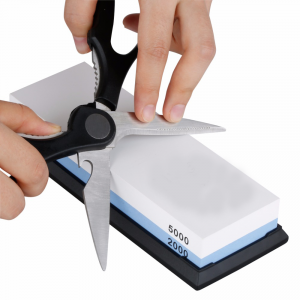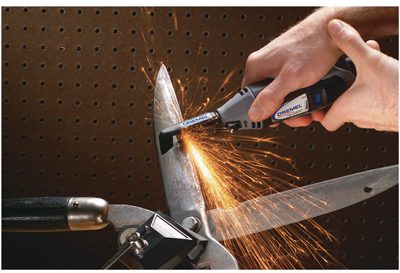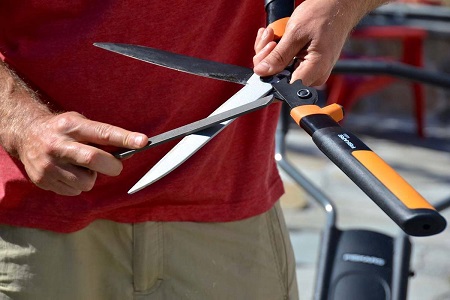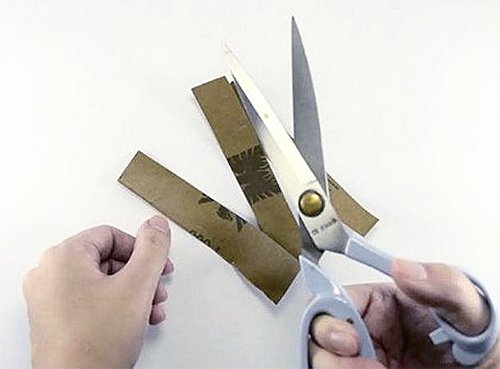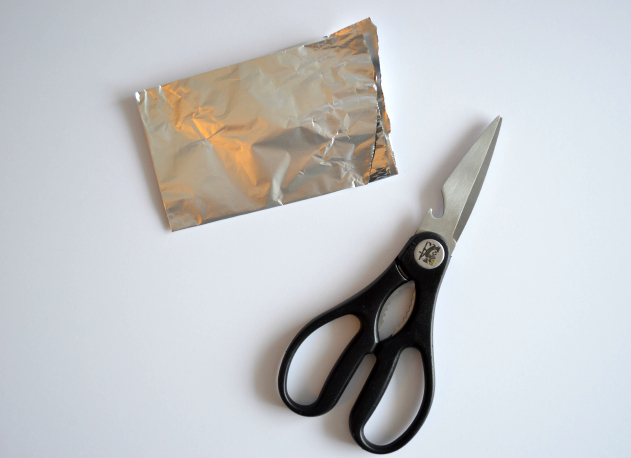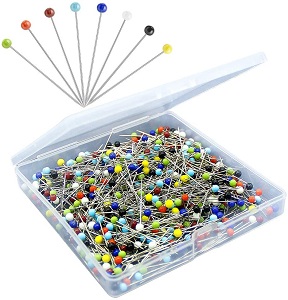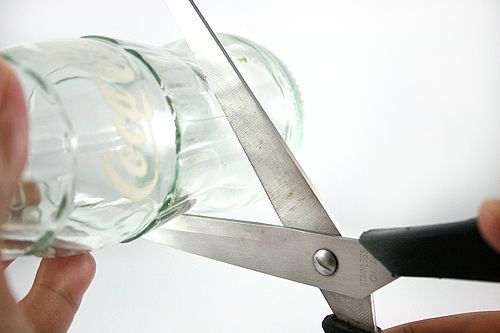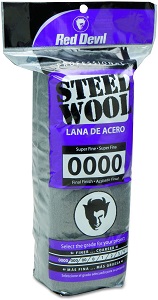
How to Sharpen Scissors : 10 Ways of Scissors Sharpening
Scissors are a cutting instrument consisting of a pair of metal blades linked so that the edges meet and cut materials located among them where are the handles are gathered. They are used for cutting many different materials like sheet metal, paper, wire, cloth, rope, or metal foil. There are so many types of scissors, and they’re made to do various jobs.
2 best tools for sharpening the scissors are:
- Wheels that fit Dremel
- Sharpening stones
The best scissors are sharp scissors. We will show you 10 quick tips on how to sharpen scissors.
Stone Sharpening
Step #1 Get a Sharpening Stone
You can buy a sharpening stone at any hardware store, and it can be used for any blade. Sharpening stones regularly have 2 sides: a rougher side and a fine side.
- If your scissors are very dull, you should first use a rougher side and then use a fine side to finalize sharpening.
- If you want a fine sharpening, you should only use a fine side of a stone.
Step #2 Prepare for Stone Sharpening
Put a towel beneath your sharpening stone and cream it with honing oil or water.
- Best oil for the sharpening stone is honing oil, but you can use any oil or water. It works well enough for lubricating the stone.
Step #3 Take Apart your Scissors
Remove the bolt that keeps your scissors blades together. You must do this to sharpen the blades separately and have more mobility when sharpening the knives.
Step #4 Sharpen the Inner Side
Put the inner side of the one blade on the stone facing down—the sharp angle between the cutting edge and the inner edge. The area where the two edges meet in place needs to be sharp to cut stuff. Hold the handle of the scissors blade, and softly drag the blade over the stone facing you, carrying the edge of the blade versus the stone.
- Do it again nicely and slowly, as far as the blade has been sharpened. This requires about 5-15 pulls.
- Perform this step with the other blades of the scissors.
- Exercise with some old scissors until you are utterly skilled in sharpening the scissors.
Step #5 Sharpen the Cutting Edge
Keep the handle of the scissors blade and lean the blade ahead of yourself while the cutting edge lies on the stone. Next, position the blade horizontal to you, slowly drag the blade over a stone in your direction, holding that chamfered edge flat vs. stone. Fit the angle and carry on moving the blade progressively. Rerun this operation precisely until the blade is sharpened.
Step #6 Get Rid of the Burrs
When you finish sharpening the scissors, you’ll notice specific rough burrs of metal across the sharpened edges of the blades. Burrs can quickly be removed by setting the scissors back together and opening and closing them a few times.
Test your scissors by cutting through some material like paper or fabric.
Step #7 Clean the Scissors
Use a paper towel to clean down the blades and wipe off any stone scraps that may have piled on the blades during sharpening.
How to Sharpen Scissors With a Dremel
Step #1 Separate Scissor Blades
Take apart the two scissor blades. You can separate them by disconnecting a screw found in the middle of scissors.
Step #2 Position the Scissors
Put one of the scissors blades into the vise with the sharp end turn outside. One side of the blade should be tilted downward, positioning in the sharp edge as at the same time the other side will not be tilted. Setup the scissors so that the angled side faces upward.
Step #3 Start a Dremel
Put the disc into a Dremel and get started.
Step #4 Keep the Angle
Control the Dremel versus the top of the scissors blade at a 10° angle and abrasive.
Step #5 Grind the Scissors
Carry on rough along the length of the scissors at that angle until the whole edge is sharp.
Step #6 Remove the Scissors
Take out the scissor blade from the vise.
Step #7 Repeat Steps
Perform the steps from 2 to 5 again with the other scissor blade.
Step #8 Mount the Scissors
Mount the scissors blades by screwing them together again.
How to Sharpen Scissors with a File
Step #1 Obtain a File
It’s best to use a medium file length for sharpening scissors. Because the scissors are small, and you don’t need a big file.
Step #2 Prepare a File
Use a 10-inch file.
Step #3 Disassemble your Scissors
Remove the bolt that connects the scissor blades. Do this, so you can sharpen each blade once at a time and have more flexibility while sharpening the knives.
Step #4 Sharpen the Scissors
Hold the file in one hand and the scissors in the other hand and drag across the inner blade of the scissors from the base of the blade until they reach the tip. Do it 5-10 times.
Repeat that action with the other blade.
Step #5 Mount the Scissors
Screw the bolt in the middle of the scissors mechanism that connects blades.
Step #6 Wipe the Blades
Take a paper towel and wipe off any metal bits on the blades during the sharpening with a file.
Sandpaper Scissors Sharpening
Step #1 Acquire a Piece of Sandpaper
Use medium-grit sandpaper if you want smooth edges of scissors. Bend your sandpaper fifty-fifty, with the rough sides turn outside. Have the rough edges turn out, so the sandpaper scrapes over two blades while you cut the paper.
Step #2 Cut Through the Paper
You need to cut through sandpaper, cutting long slices, about 15 times. You’ll see that blades become sharper with every piece you’re cutting. Use entire strokes of the scissors, start the cutting at the beginning of the scissors going up to the top.
- Sandpaper cutting is suitable for scissors that aren’t extremely dull but need a little bit of sharpening.
- Sandpaper is also helpful for taking off the cuts and kerfs.
Step #3 Clean up the Scissors
Clean up the blades of the scissors using a damp paper towel to remove any sandpaper scraps that may have appears on the edges during the sharpening.
Scissors Sharpening with Aluminum Foil
Step #1 Grab the Foil
Use a bit of aluminum foil, about 10-15 inches long, and bend it in lengthways several times, so you have a folded and a tick foil.
Step #2 Cut the Foil
Cut ribbons of the aluminum foil with your scissors until you cut the whole of the thick aluminum ribbon. Then, start cutting at the base of the scissors and move it to the top.
- According to the area of the ribbons that you cut, you can sharpen your blades a lot by cutting many small ribbons or a little by cutting several thicker ribbons.
Step #3 Clean the Scissors
Use a paper towel and get it slightly wet with warm water. This will wipe off any aluminum remains that may have accumulated on the blades during your cutting.
Sharpening Scissors with a Sewing Pin
Step #1 Purchase a Sewing Pin
You can buy a sewing pin at any store or order online.
Step #2 Start Pin Cutting
Hold the scissors closed and pull the pin out from the blades as the scissors close. Do not use heavy pressure to close the scissors but let the sewing pin do the sharpening for you. Then, do it a few times more, as far as the blades have a flat, sharp edge.
Step #3 Clean the Scissors
Use a wet paper towel and clean the scissor blades from any metal remaining that may jump on the blades during the pin cutting.
Sharpening the Scissors Using Glass Jar
Step #1 Position the Scissor Blades
Spread the scissors as much as you can and set the blades around the glass jar sides.
- The glass jar should be at the position that it can go between two blades.
- Keep the jar in one hand and the scissors in the other hand.
Step #2 Cut the Jar
Hold the scissors closed and move the glass jar out of the blades as the scissors close. Close the scissors with low pressure, and the glass will sharpen for you.
- Repeat the action until you get a flat, smooth edge.
Step #3 Clean the Blades
During the sharpening, many small glass parts may have collected on the blades while cutting the glass jar. Because of that, you should use a wet paper towel to clean the scissor blades.
How to Sharpen Scissors with a Knife Sharpener & Special Scissor Sharpener
Sharpeners are safer, and they are much more accessible for use. Depending on what type of scissors you have, you can use a specially designed scissors sharpener or a knife sharpener.
Scissor sharpeners are fine and safe to use and can instantly sharpen the two blades. On the other hand, knife sharpeners are suitable for sharpening because they can be used for different types of blades.
Follow these few steps to learn how to sharpen scissors:
- Take apart your scissors. Use the inner side of the blade and put in the knife sharpener. Drag the blade over a knife sharpener about 10 times. Repeat that process with the other blade. Do it until you get the sharp edge that you need.
- Hold scissors and just put them in the gap of the scissors sharpener mechanism and press the scissors handles as you cut 10-15 times and you have razor-sharp scissors.
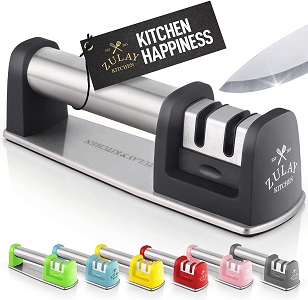
Sharpening Scissors with Alcohol
Alcohol is more of a cleansing agent than a scissors sharpener, but it can be a great way to keep your hair scissors sharp and functional.
- Most hair products contain non-water soluble ingredients, which results in a build-up of residue on your scissors. It later leads to diminished cutting performance.
- Soap and water cannot remove the residue from the blades, and it is essential to use alcohol to clean them.
Here is how to use alcohol to sharpen scissors:
Step #1 Add Some Alcohol to a Paper Towel
Add a few drops of isopropyl alcohol to a paper towel. Note that isopropyl alcohol is highly flammable. So keep it away from heat sources.
Step #2 Clean and Sanitize the Blades
Clean blades thoroughly with a paper towel you’ve previously wet with alcohol.
Sharpening Scissors with Steel Wool
You can use a piece of steel wool to sharpen scissors. It can convert your blunt blades into razor-sharp cutters quickly and efficiently, thanks to its abrasive properties.
Follow the steps to see how to sharpen scissors with steel wool:
Step #1 Get a Steel Wool
You can find steel wool at any store, or you might have extra ones at your home.
Step #2 Cut a Steel Wool with Scissors
Take a piece of steel wool and cut it with scissors for about one minute.
Use a Scissors Sharpening Service
If you have many scissors to hone or are afraid to damage the blades with DIY methods, consider a scissor sharpening service. This type of service is excellent for sharpening professional scissors, such as those used in barbershops, hairdressers, sewing, etc.
- You can either mail your scissors to a scissor sharpening service or have them sharpened by a nearby brick-and-mortar store.
4 Nifty Ways to Keep Your Scissors Sharp and Functional for a Long Time
To extend your scissors’ lifespan and ensure their utmost sharpness and performance, you need to clean them regularly and store them properly.
Here is how:
Tip #1 Clean Scissors with Water and Dish Soap
Use water and dish soap to clean the scissors and remove any residue and stubborn dirt from the blades. If you are dealing with sticky residue or rust, try white vinegar and the rough side of the sponge.
Tip #2 Sharpen Scissors That is Dull
If you are not sure whether your blades need sharpening, gently close the scissors on a piece of silky fabric. If the material folds on the sides of the edges instead of being nicely cut, they need to be honed.
Consider some of the methods mentioned in the article to have your blades sharpened to a T.
Tip #3 Keep Scissors in the Right Place
If you keep your scissors in a drawer crowded with other stuff, they are more likely to get damaged. Instead, keep them in a separate box or protect them with a piece of fabric. Never keep your scissors in a humid place, such as the bathroom.
Tip #4 Use Different Scissors for Different Purposes
Make sure you’re using specialty pairs for their intended purposes to keep your blades sharp longer. For instance, use one specific pair for cutting fabric, another for paper, etc.




